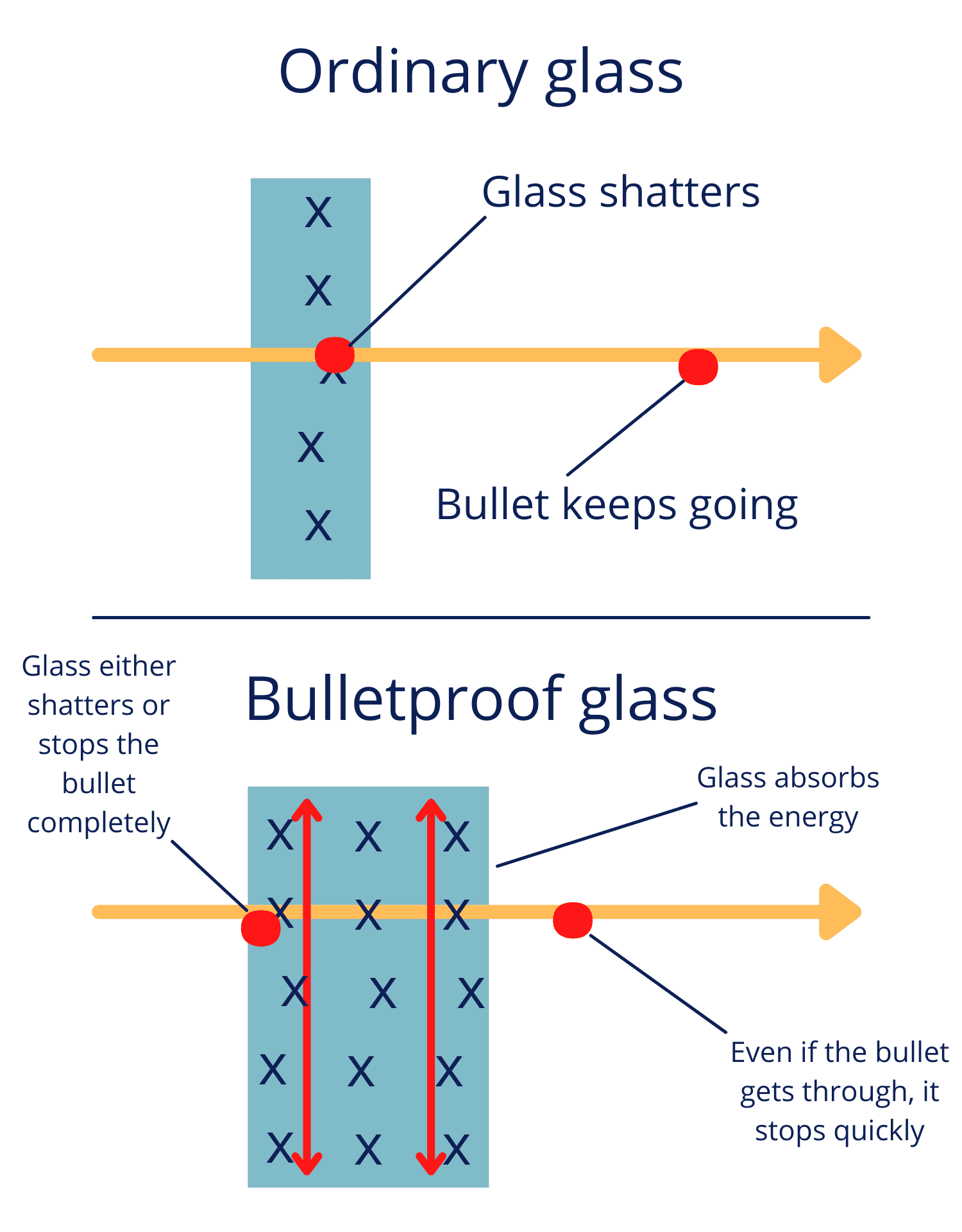
Let’s establish the basics first.
While the modern world colloquially refers to the material in question as “Bulletproof”, a better term to use is bullet resistant.
Even at the highest levels of protection, there is always a large enough or a powerful enough bullet fired repetitively that can defeat even the strongest glass.
However, is a threat from a .50 caliber weapon fired multiple times at a school or a business likely? Of course not; the assailant is likely to get disarmed before they ever manage this.
Still, it’s good to clarify; especially in the light of needing to make a decision to protect against the kinds of threats that a school, a business or a municipality might face.
How did bulletproof glass use to get made?
“Old time” bulletproof glass was generally made by fusing piece upon piece of actual glass together with a bonding agent like polyvinyl butyral (PVB) to form a thick barrier.
This process required high heat and immense pressure to “laminate” the glass together. While well regarded for good clarity, this type of bulletproof glass can be a nightmare to work with, both architecturally and logistically.
To protect against modern threats like semi-automatic rifle fire, this product would generally have to be over three inches thick and over thirty pounds per square foot. Imagine transporting something like that to a job site and then maneuvering it into an opening!
Second generation glass
Utilizing acrylic was the next step in the evolution of bullet resistant glass. Originally, a simple .75-1.5” thick piece of acrylic was substituted for regular glass.
Later, manufacturers would laminate acrylic to regular glass to increase effectiveness.
However…
The issues with acrylic are twofold. Firstly, the bullet resistance of acrylic is somewhat marginal. It only provides protection against the least powerful, lowest caliber handguns. Secondly, acrylic tends to break down over time. It loses clarity and strength.
The modern process of making bulletproof glass
Ultimately, bulletproof glass technology moved towards a polycarbonate-based manufacturing process.
Here’s how the process of making the glass goes.
- A “sandwich” is created using traditional glass and sheets of poly. Of course, many different types of these materials exist and each manufacturer has a different process for fusing the layers together.
- The traditional glass and sheets of poly are laminated together in an industrial “cooker”. This uses heat of over 300 degrees Fahrenheit and pressure of more than 10 atmospheres. This process creates a stronger, bubble free product that stands the test of time.
- Layers are added to the “sandwich”, up until the desired thickness is achieved. The more layers, the more bullet resistant the end result is. More commonly now the “sandwich” is open faced meaning that the polycarbonate is added to the safe side only.
To keep things simple, let’s stay with the food theme.
Just like every fine meal is dependent on using the best ingredients and the best preparation, such is the case with bulletproof glass.
We like to think of ourselves as a five-star restaurant. There are many types of polycarbonates out there, and many types of base glass. Our “head chef” and co-founder, the late Richard Newton, spent the better part of a lifetime researching and developing his masterpiece, BallistiMAX. While we can’t share the exact “recipe”, obviously, we can tell you some facts.
Features of modern bullet resistant glass
- It’s strong. Our glass is designed to withstand multiple rounds from semi-automatic rifle fire, like that from an AR-15 or AK-47.
- It’s light. BallistiMAX weighs 11 pounds per square foot.
- It’s thin. At 1.375 inches, the product works great in just about any architectural or construction environment. In fact, we can even retrofit it to existing glass and frames.
- It’s proactive. Our unique formulation creates an effect called BallistiSHOCK, where a spray of materials is sent hurtling back in the direction of the shooter; often disabling them with shards of glass.
- It’s reactive. The unique design utilizes COUNTERFIRE technology so that armed individuals on the safe side have the ability to return fire at an assailant.

How does bullet resistant glass work then?
Think of yourself as a baseball player standing 60 feet away from a pitcher, throwing the ball at 100 miles per hour. If you try to catch that pitch with just your bare hands; well, things are probably not going to end up well.
Your hands won’t absorb much (or any) of that energy and that ball is likely going to end up striking you in the face.
That is more or less what a regular glass window will do to a bullet; slowing it down ever so slightly, but not anywhere near enough to prevent danger.
Now…
Think of the layers of polycarbonate. That is the glove that you use to catch the ball.
If you were to put on a golf glove, that might help a bit; but not enough to keep you from stinging.
A regular baseball glove?
Well, that’s a little better; but you’d move your hand back to absorb the momentum of the ball. There’s the reason why the catcher uses a specific glove – because the thickness disperses the energy coming at it.
Such is the case with polycarbonate. By using the best materials and optimum thickness, the energy of a bullet is spread out sideways; slowing it down to the point that the last piece stops it cold, without spalling or penetration.
We have worked with schools, religious organizations, courthouses, city halls and police stations to protect the people inside. As the manufacturer and installer of BallistiMAX, we have an advantage when it comes to doing your project right, and at the right price. Once you’ve decided to protect your people; why not do it with the best? Call our team at 1-800-960-4097 and we can help you plan, fund, and install your project the right way!

Can this be applied to an existing sliding door.